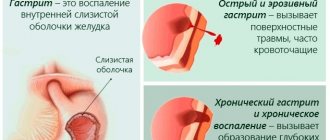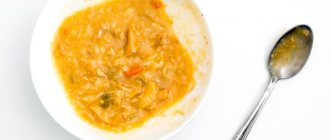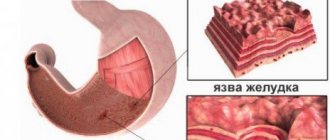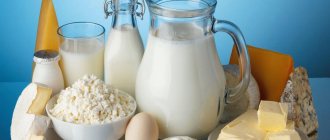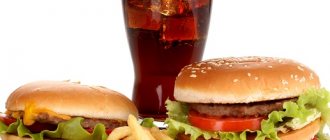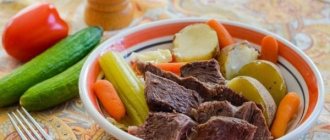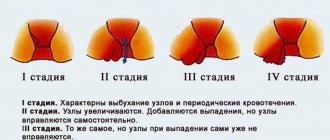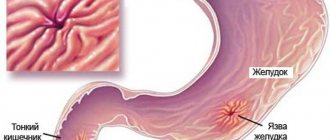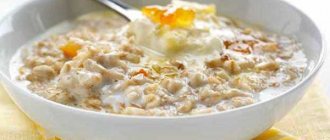The modern rhythm of life and proper nutrition are concepts that are most often incompatible, because work pressure and an abundance of fast food establishments force you to snack in your spare time on not very healthy food, full of fats, preservatives, and spices. The results will not take long to arrive - unpleasant discomfort in the abdominal area will result in serious diseases, among which gastritis is considered the most popular. Doctors warn: drug treatment will be ineffective without a special diet, so the diet for gastritis should occupy a central place in the course of treatment.
What you can and cannot eat during exacerbation of gastritis
Gastritis is a disease of the stomach.
Even superficial gastritis in the acute stage can cause such unpleasant symptoms as heaviness and pain in the epigastric region, belching. Treatment of a disease should always begin with a change in diet. To create the correct menu, you need to know the form of the disease. This can be: gastritis with low acidity, with high acidity, erosive, antral, chronic, sluggish, and so on. When exacerbating any form of gastritis, the level of stomach acidity is important. A doctor can determine it. Depending on this indicator, therapeutic nutrition will be built.
The diet for gastritis in the acute stage includes the following principles:
- Compliance with fractional multiple meals.
- Eat slowly and chew well.
- Food should not have strong flavors. Avoid spices and sauces.
- Food should be at medium temperature. Heavy fatty foods are prohibited.
- Avoid alcohol and carbonated drinks.
- Wash your food down while eating.
- Give preference to lean varieties of meat.
Chronic gastritis in the acute stage with increased acidity.
People with high acidity are recommended to eat soft pureed food warm and without a lot of spices. Of flour products, only yesterday's bread is allowed.
The diet for gastritis in the acute stage includes the following products:
- Lenten soups with vegetables, cereals or noodles. It is very useful to prepare puree soups.
- Among cereals, give preference to rice, buckwheat, and oatmeal.
- Choose lean meat varieties. Prepare dishes with a soft consistency: (cutlets, meatballs, soufflé).
- Steam, boil, bake or stew dishes.
- Dairy products are allowed in any form.
- Add eggs to the omelet.
- Eliminate canned food, marinades and pickles.
- Sweets prohibited: chocolate, ice cream, soda and halva.
With low stomach acidity, nutrition is somewhat different. Choose products that can increase acid secretion without damaging the mucous membrane. The basis of the diet should be:
- strong broths and soups;
- lean varieties of fish and meat;
- steamed vegetables.
Avoid eating foods that cause fermentation. Prohibited: cabbage, legumes, milk, cookies. Food that irritates the stomach is also prohibited (alcohol, spices, canned food, marinades).
- Omelette of two eggs, crackers, rosehip decoction.
- Cottage cheese, chamomile tincture.
- Chicken noodle soup, turkey cutlets, jelly.
- Unsweetened yogurt, rose hip decoction.
- Oatmeal with a piece of butter, a glass of milk.
- A glass of kefir.
The menu for chronic gastritis is compiled on the basis of therapeutic Diet No. 1, which can be modified depending on the stage of the disease and the patient’s well-being. At the same time, it is important to follow the principles of heat treatment, the list of permitted/prohibited foods and the diet option - with pureed/unprocessed dishes. If milk is poorly or completely tolerated, it should be replaced with other products or used as an additive to weak tea or coffee.
Most often, chronic gastritis is asymptomatic and manifests itself in the form of exacerbations only against the background of weakened immunity, damage to the gastric mucosa by Helicobacter, malnutrition, frequent stress and the development of other diseases of the internal organs. The exacerbation process manifests itself in the form of disruption of the main function of the stomach - digestion, as well as irritation of its inflamed mucous membrane.
When following a diet with exacerbation of chronic gastritis, split meals in small portions from 5 to 8 times a day are recommended; the calorie content of food should be 2800-3000 kcal per day. Exacerbation of gastritis was observed in patients who reduced their daily fluid intake - that is, less than 1.5 liters per day. In modern medical practice, patients during an exacerbation of chronic gastritis in the first days of treatment are prescribed table No. 1a, then - table No. 1b, and in the process of reducing the symptoms of the disease (about a week) - table No. 1.
As for the menu, it should consist of easily digestible products and dishes.
- lean meats, poultry, fish (boiled, stewed and baked);
- soups;
- steam omelettes;
- dairy products;
- dry biscuits and crackers;
- unsweetened drinks;
- natural juices, weak tea with lemon, dried fruit compotes;
- fruit jelly.
It is advisable that the food is well chopped. When making soups, it is important that they have a slimy consistency. Boiled vegetables are best consumed as a puree. Raw foods are excluded from the diet (grains, fruits and vegetables, legumes).
It is best to give preference to easily digestible dishes: for example, boiled meat or fish, as well as steamed cutlets, zraza, meatballs, etc. You can use egg whites, milk and cream, low-fat cheese, low-fat yogurt and kefir. From fats - vegetable products in the form of olive or refined sunflower oil, which must be used when preparing dishes.
- bakery products, fresh pastries;
- fatty foods, smoked products, sausages and marinades;
- spicy and salty foods;
- fried foods;
- cold drinks;
- alcohol;
- ice cream;
- sour foods;
- any spices.
- First breakfast. Any slimy porridge or hard-boiled eggs, a glass of weak tea, milk or compote.
- Lunch. Fruit jelly or marmalade.
- Dinner. Any puree soup, for the main course - porridge or mashed potatoes with steamed meat or fish gravy, crackers, tea with milk.
- Afternoon snack. Cookies (biscuits) and rosehip decoction with honey.
- Dinner. Semolina porridge with butter (50 g) or with meat soufflé, fruit jelly, compote.
- Before bed: a glass of milk.
Factors that can provoke an exacerbation of gastritis are dishes that irritate the walls of the stomach and increase the inflammatory process. Such dishes are: cold or hot food, seasonings, pickles, spices.
During an exacerbation, it is important to strictly follow the therapeutic diet, and on the first day, completely refuse food. Gastroenterologists recommend drinking still mineral water, rosehip decoction, and weak tea during the period of refusal to eat. In total, you need to drink at least two liters of fluid per day.
On the second and subsequent days, you need to gradually expand your diet and begin to include boiled or steamed foods in the menu, without the use of salt and spices.
When eating during an exacerbation, the following rules must be observed:
- dishes must be pureed;
- You should eat at least 5 times a day, portions should be small, overeating should be avoided;
- food consumed should be at room temperature;
- exclude alcoholic and carbonated drinks;
- the cooking technology strictly excludes frying; only boiling or steaming is allowed;
- Fatty and difficult-to-digest foods (for example, seeds, nuts, chocolate) are contraindicated;
- the duration of a strict diet can be two weeks, but sometimes one week is enough;
- the range of dietary dishes for acute gastritis in medicine is listed as “Table No. 5a”.
There are a number of recommendations that help quickly restore the inflamed gastric mucosa:
- Drink a glass of clean water on an empty stomach in the morning. This helps cleanse the organ of mucus that has accumulated overnight;
- do not be nervous. In this case, overstrain of the gastric mucosa occurs through brain signals;
- follow the diet. It is necessary to eat food at the same time to avoid excessive synthesis of gastric juice;
- consume enough fiber - it stimulates the intestines and helps cleanse them.
Depending on the acidity of the stomach, a diet will be prescribed during attacks of the disease. The form of the disease also matters; it can be: erosive, antral, chronic, superficial, mixed and other types of gastritis.
Compliance with the general rules of proper nutrition will help relieve the symptomatic signs of acute gastritis, and violating the diet will only worsen the patient’s condition.
Table of products that are allowed or prohibited during an exacerbation of the disease
| Allowed to eat | Prohibited Products |
| Cream, granular cottage cheese (low-fat cottage cheese), milk, butter (no more than 50 g per day), mild hard cheese | Smoked meats, pickles, marinades, canned food, sausages, frankfurters |
| Lean meat and fish (steamed cutlets) | Fatty meats and fish (dried, fried), lard, pork |
| Soft-boiled eggs, white omelette | Fried eggs |
| Olive oil | Chocolate, ice cream |
| Pasta casseroles | Legumes (beans, peas) |
| Ground puddings | Dried flakes |
| Rose hip decoction | Tea and coffee (strong), cocoa |
| Fruit juices (diluted), tea (green), berry jelly, compotes | Alcohol products, kvass, carbonated drinks |
| Some types of vegetables (potatoes, carrots, pumpkin) pureed or steamed | Tomato paste, fresh vegetables (radishes, tomatoes, sorrel and others) and fruits |
| Porridge (semolina, buckwheat) | Pshenka |
| Bread made from durum wheat | Fresh bread and other types of flour |
| Vegetable broths with added cereals | Processed cheese |
| Honey, marshmallows, marshmallows, soufflé (in small quantities) | Mushrooms |
Each type of gastritis has its own nutritional nuances; it is important to know the form of gastritis, since when it worsens, a diet that is suitable specifically for this form should be prescribed.
In the acute stage of gastritis with low acidity, it is important to relieve the inflammatory process and help restore the production of hydrochloric acid.
Therefore, when drawing up a diet for this type of gastritis during an exacerbation, it is taken into account that food should better stimulate the secretion of juice, on the other hand, not irritate the inflamed organ and remove the main symptoms of the disease:
- heartburn;
- feeling of heaviness after eating;
- dull pain in the abdominal area;
- increased gas formation and bloating;
- burp rotten.
The principles of nutrition should be:
- lack of fatty and fried foods in the diet;
- eating less fiber;
- Chewing food thoroughly.
List of foods that can be consumed:
- lean meat (beef, rabbit, turkey);
- vegetables that do not irritate the walls of the stomach (steamed);
- apples and pears, fresh, peeled or baked;
- dairy products;
- strong broths and soups;
- low-fat fish.
Sample menu for the week
When dieting for high stomach acidity, you can use the following examples to create a menu for the week:
Option #1
- Breakfast. Carrot zrazy with fruits, milk tea.
- Lunch. Low-fat cottage cheese ground with sugar.
- Dinner. Stewed vegetables with veal, vegetable soup with breadcrumbs, compote.
- Lunch. Carrot pudding, tea.
- Dinner. Mashed potatoes, steamed fish, rosehip infusion.
- Snack. A glass of milk.
Option No. 2
- Breakfast. Boiled buckwheat porridge, rosehip infusion.
- Lunch. Fruit jelly.
- Dinner. Steamed chicken soufflé with stewed vegetables, pureed vegetable soup, juice.
- Lunch. Long pastry cookies, green tea.
- Dinner. Lazy dumplings, tea.
- Snack. A glass of curdled milk.
Option #3
- Breakfast. Low-fat cottage cheese casserole, milk tea.
- Lunch. Baked apple.
- Dinner. Fish pudding with a side dish of potatoes, chicken broth with breadcrumbs, compote.
- Lunch. Fruit jelly.
- Dinner. Rice pudding, steamed chicken cutlets, weakly brewed black tea.
- Snack. A glass of milk.
Diet for gastritis in the acute stage: menu
Gastritis manifests itself with a whole set of symptoms:
- nausea and vomiting;
- sharp or aching pain in the upper abdomen;
- swelling;
- frequent belching;
- problems with stool;
- lack of appetite and even weight loss.
Along with drug treatment, it is very important to choose a diet. When diagnosing a disease, many are interested in the question: “What diet is suitable for chronic gastritis?” As a rule, a gastroenterologist decides to prescribe a diet on an individual basis, taking into account the characteristics of the disease, symptoms, the patient’s condition, as well as test results (in particular, the level of acidity of gastric juice).
The diet for chronic gastritis is primarily aimed at normalizing the digestive system and consists of frequent consumption of easily digestible food. It is better to steam, bake, boil and stew dishes. Food should be ground to a soft consistency. You should not eat cold or hot dishes; the best option is slightly warm.
General recommendations for prescribing a diet for chronic gastritis include limiting spicy, salty and coarse foods, and avoiding fatty, smoked and fried foods. It is important that the patient’s body receives all the necessary microelements and nutrients, so the menu must be composed of light and, at the same time, nutritious dishes.
Typically, the diet for chronic gastritis lasts 1-1.5 months - until the condition is completely improved. However, some rules of rational nutrition must be followed throughout life: do not overeat, chew food well, give up alcohol and smoking, as well as fast food, carbonated drinks and other harmful foods.
The diet for chronic gastritis is based on the principle of fractional meals (meals 4-5 times a day). Dishes must be freshly prepared and made from natural ingredients. To quickly restore digestive system function, you need to include protein foods in your diet, as well as vitamins E, B12 and B6 (found in a variety of grains, dairy products, lean meats and fish, eggs and dark green leafy vegetables).
In case of chronic gastritis, it is necessary to remember the use of fresh fruits, berries and vegetables, which help to enhance the processes of gastric secretion, the secretion of gastric juice and increased enzyme activity. Assimilation of meat and fish occurs much faster if they are eaten in combination with vegetables. Among the spices, it is allowed to use parsley, celery, and dill in crushed form.
The diet may include:
- yesterday's or dried bread;
- low-fat cookies;
- vegetable and milk soups;
- porridge (puree, slimy);
- dairy and fermented milk products;
- dishes made from lean meat or fish;
- oil (in small quantities);
- refined vegetable oils (olive, sunflower, etc.);
- meatballs, soufflé, cutlets, zrazy made from lean meat, poultry and low-fat fish;
- vegetable stew;
- puree soup prepared with low-fat broth;
- steamed omelettes;
- fruit mousses and desserts;
- jelly and marmalade;
- Drinks include weak tea (including milk), clean water, rosehip decoction, mineral water, juices, dried fruit compotes.
The following are excluded from the diet:
- rich meat, fish or mushroom soups (instead, light broth or milk soup, which will help neutralize excess acid in the stomach);
- fatty foods, smoked foods;
- alcoholic drinks;
- strong coffee, cocoa and tea;
- some fresh vegetables: cucumbers, peas and beans, cabbage, radishes and turnips, onions and sorrel;
- mushrooms;
- dishes and foods that are slowly digested in the stomach: rye bread, pancakes, pies;
- fried and hard-boiled eggs;
- any canned food;
- spices;
- cheese.
The choice of diet will depend on the degree of development of the disease, the patient’s condition and individual characteristics. When the condition worsens, the patient adheres to a strict diet; after treatment, during remission, the menu expands significantly. Regardless of the stage of chronic gastritis, food should be complete and include vitamins, microelements, and nutrients that are necessary for recovery.
Typically, for chronic gastritis, tables No. 1, No. 2, No. 15 are often prescribed, depending on the course of the inflammatory process. Thus, during an exacerbation of the disease, table No. 1 is used, which boils down to eating exclusively pureed foods, boiled or steamed. This strict dietary treatment can last up to 2 months. During the process of remission, a transition occurs to table No. 2 (extended menu), then to table No. 15.
Table No. 2 is prescribed when the stage of exacerbation of chronic gastritis passes. It is allowed to eat soups prepared with meat or fish broth, light borscht and pickle soup. You can add doctor's sausage, sauces from meat broths, berries or soft fruits to your diet. Prohibited foods include mushrooms and raw vegetables.
Table No. 15 significantly expands the menu and may include the consumption of rye bread, raw vegetables and fruits and other products. However, fatty foods, smoked foods, canned food, vegetables (for example, turnips, radishes and radishes) are excluded, as they irritate the gastric mucosa.
A wide range of products that are allowed for chronic gastritis allows you to create a varied diet and make it tasty and enjoyable.
Breakfast It is advisable not to strain the digestive system with large quantities of food. It is enough to eat a small portion of porridge (oatmeal or semolina) for breakfast. You can add pieces of steamed meat or fish. Other options: protein omelet, hard-boiled egg, vegetable puree, lean fish, baked or boiled.
Second breakfast (after 2 hours) As a snack, you can drink a glass of compote or milk, wild rose decoction or jelly. A sandwich of dried bread or buns with butter (in small quantities) with doctor's sausage is allowed.
- first course - vegetable or milk soup (including with the addition of cereals), cabbage soup;
- second - a vegetable salad or meat dish with a side dish (pasta, mashed potatoes, boiled carrots or beets);
- drink - compote, herbal decoction or jelly.
As a dessert, you can eat a skinless baked apple in sugar syrup, curd soufflé, fruit pudding or berry mousse.
Afternoon snack A glass of tea (milk, low-fat kefir, dried fruit compote, berry jelly) with cookies, crackers, a sandwich or a dry bun.
Dinner You can cook boiled potatoes, baked fish, semolina porridge, or any other porridge, cottage cheese with milk, or an omelet. For drinks, weak tea or warm milk is preferable.
Before going to bed, drink a glass of warm milk with honey or kefir.
The menu for chronic gastritis can be varied: vegetable salads, boiled fish, puree soups, meat soufflés, lazy dumplings, protein omelettes, dietary sausages, various cereals and fruit and berry jelly. The main thing is that the food is easily digestible and does not contain ingredients that irritate the gastric mucosa.
Lazy dumplings
Rub a package of low-fat cottage cheese through a sieve, add 1 tbsp. a spoonful of wheat flour, a teaspoon of sugar, an egg and mix thoroughly. Make sausage from the resulting mass and cut it into small pieces. Place dumplings in boiling water and cook for 5 minutes. Serve with a small amount of low-fat sour cream.
Peel 250 g of cauliflower and cook in beef broth (300 g), then rub through a sieve. Fry the flour with vegetable oil (5 g), dilute with broth, then add to the mashed cauliflower and pour everything into the broth. Cream (50 g): mix 1 egg yolk and 5 g of vegetable oil. Bring the soup to a boil, season with cream. Add bread crumbs (20 g) before serving.
Boil 1.5 cups of milk, then carefully add semolina (1 tablespoon) into it and cook for 20 minutes, stirring constantly. At the end add 1 teaspoon of butter and the same amount of sugar. You can add berry puree to slightly cooled soup.
Rinse 100 g of dried fruits thoroughly, then add hot water (450 g) and boil. Add 20 g of sugar and leave in a closed saucepan for 1 hour. Cook rice separately (10 g), rinse it with cooled boiled water and add to the fruit broth.
Peel and bone pike perch (250 g), cut into pieces, then steam and pour over milk sauce before serving. For milk sauce: 50 g milk, 5 g flour, half a boiled egg and 20 g butter. Part of the milk is brought to a boil and poured into flour, previously diluted with the rest of the milk, then a crushed egg, salt and butter are added.
Meat (250 g chicken or 200 g beef) must be minced, then add bread (10 g) soaked in milk, and mince again. Pour a little water or milk into the minced meat, add salt, stir and form small balls that should be steamed.
Chop the carrots (75 g) and apples (75 g), mix the ingredients, add chopped walnuts (25 g), honey (25 g) and parsley (10 g).
- rice and corn soup. To do this, boil diced meat and rice for 20 minutes. Add diced potatoes to the broth, and when ready, add cooked rice and corn. The soup must be salted and herbs added;
- rice porridge with pumpkin. Boil 500 g of pumpkin (pulp), adding a little sugar, and boil 10 tablespoons of rice separately. Pumpkin is pureed and added to rice, the porridge is stirred and poured with melted butter;
- casserole of carrots and cottage cheese. To do this, grate 3 carrots and simmer them until tender with milk (150 ml), 1 tbsp. a spoonful of butter and 3 tablespoons of honey. After this, add semolina to the stewed carrots and leave on the fire for a few more minutes. Separately mix cottage cheese (0.5 kg) with 3 eggs, salt, 1 tbsp. spoon of starch and add sugar to taste. Cottage cheese is mixed with carrots and baked in the oven for 30-45 minutes at 180C.
https://youtu.be/BD1uRDXJMW0
The norm of dishes for a sick stomach
All patients with gastritis know that their meals should be divided, that is, they need to eat 5–6 times a day. And if everything is more or less clear with an afternoon snack and a glass of milk at night, then the volumes of food portions during an exacerbation, and even outside of it, raise many questions. How to determine your own individual norm? We will tell you about an interesting and simple “fist-palm” method.
If you clench both palms into a fist and bring them together, you will get the approximate volume of your stomach. That is, the portion should not be larger than this volume either during an exacerbation or in a normal state. A balanced diet includes the following amounts of food per day so that the stomach does not experience stress:
- Vegetables - in the amount of 1 fist. In case of exacerbation of gastritis, this norm implies a pureed vegetable dish from boiled products.
- Grated meat/fish/chicken dish – no more than 1 palm.
- Cereal dishes – 1 fist.
- Soup - 1 fist, to make it easier - no more than a glass.
The fist theory has interesting features: for example, the daily portion of butter is equal to the size of your thumbnail; if you put your thumbs together, their size will correspond to the volume of a tablespoon.
This interesting theory is not used in hospital nutrition; scales are used for this. And at home, it is quite possible to use the palm method.
Fractional nutrition promotes mechanical sparing of the stomach and does not allow the organ to remain inactive. Eating every 2-2.5 hours helps protect the mucous membrane from the aggressive effects of hydrochloric acid - it is used to digest small portions of food.
Increased stomach acidity
Reduced acidity of the digestive organ implies insufficient acid production, and therefore poor digestion of food. For this reason, you need to create a menu so that the food, on the one hand, stimulates the secretion of juice for digestion, and, on the other hand, does not irritate the body.
The principles of nutrition in such a situation should be:
- Refusal of fatty and fried foods.
- Food should not be rough, so avoid lots of fiber.
- Chew your food thoroughly.
The main diet should include the following products:
- Only lean meat: rabbit, beef, turkey.
- Vegetables should not have an irritating effect on the walls of the stomach.
- As for fruits, you can leave apples and pears in your diet. They must be consumed either by cutting off the peel, or baked in the oven or microwave.
- Fermented milk products have a positive effect on digestion, but if you have gastritis, you will have to give up milk.
The disease is characterized by the formation of excessive amounts of gastric juice. Food must be selected taking this feature into account. They should not provoke an increase in gastric juice.
Nutrition Basics:
- Average food temperature.
- Food should not be rough. The abundance of fiber will negatively affect the patient’s condition.
- No irritating additives or chemical compounds. Soda, coffee, and alcohol should be excluded from the diet.
Main products:
- Only lean meat: skinless chicken, turkey, beef, rabbit.
- Leave only the whites of the eggs.
- From fish and seafood: low-fat fish, shrimp, crabs.
- Cereals: oatmeal and buckwheat.
- Recommended fruits and vegetables: lettuce, spinach, greens, pumpkin, zucchini, peas, beets, tomatoes, carrots, berries and any soft fruits.
Subtleties of creating a diet menu
Too cold or hot dishes provoke the development of the disease. To avoid relapse, nutritionists advise avoiding the consumption of seasonings, salty and spicy foods, and spices. Preference should be given to food that does not irritate the mucous membrane and does not contribute to excessive release of hydrochloric acid in the stomach.
When developing a menu for the week, you need to consider the following features:
- The food consumed should not contain large pieces; it is better to grind the food;
- overeating should be avoided;
- consume foods at optimal temperatures;
- exclude indigestible and too fatty foods from the diet;
- when choosing recipes for patients with exacerbation of gastritis, you should not use those in which the products are fried;
- observe strict dietary restrictions for at least 14 days.
During exacerbation of chronic gastritis, doctors advise adhering to the following recommendations:
- On an empty stomach, drink 1 glass of pure water without carbon every day. The liquid removes mucus that has accumulated in the stomach during the night's sleep.
- Avoid stress and nervous tension. When a stressful situation occurs, the gastric mucosa is also irritated, which receives a corresponding signal from the brain.
- Adjust your diet. You need to eat food at the same time, which will help prevent excess formation of gastric juice.
- When planning your diet, pay attention to foods with the optimal amount of fiber. It helps cleanse the stomach and stimulates its functioning.
Erosive gastritis
Treatment of gastric erosion is always carried out in a hospital setting and under the supervision of the attending physician and medical personnel. The complex of restorative procedures necessarily includes medications, as well as adherence to a certain diet.
Basic principles of diet for gastritis in the acute stage and in the presence of erosion:
- Fractional meals, and you need to eat in small portions, so as not to irritate your already sick body.
- Avoid fatty and fried foods.
- Light food. Food needs to be boiled or steamed.
- Liquid or soft food. After cooking, beat the dish well with a blender.
- Food should be at medium temperature.
- Avoid spicy and pickled foods.
- Coffee and strong broths are prohibited.
- Limit yourself to sweets and baked goods.
The diet for erosive gastritis in the acute stage should include:
- Slimy porridge.
- Non-concentrated soups.
- Lean meat: beef, veal, turkey, chicken.
- Fish: cod, pike, hake.
- Drinks: decoctions of dried fruits, not very strong tea, jelly.
Diet, food and nutrition
General rules in a state of exacerbation of gastritis with high and low acidity are:
- Multiple meals of a fractional nature.
- Chewing food thoroughly.
- Absence of any sauces, herbs, spices.
- The food is light, lean, and chopped as much as possible.
For patients with high acidity of gastric juice, soft pureed steamed dishes are recommended: from meat, fish, vegetables; yesterday's bread; omelettes, liquid first courses or pureed soups.
Vegetable puree soup with croutons
Expert opinion
Shoshorin Yuri
General practitioner, site expert
For those with low acidity, it is recommended to select the diet in such a way that the secretion of acid increases, but the mucous membrane is not injured. For example, this is a strong broth. Food that causes fermentation processes is prohibited for everyone.
Atrophic gastritis
Acute conditions of atrophic gastritis are treated under the supervision of a physician and taking into account all the features of the course of the disease. The main task of proper nutrition for this disease is to protect the body from external food irritants.
Basic principles:
- Soft or pureed food (can be blended with a blender).
- Moderate fractional meals. Overeating should not be allowed.
- Average temperature of prepared foods.
- Eating fatty and fried foods is prohibited.
- Food must be baked, boiled or steamed.
A diet for gastritis in the acute stage should exclude the following foods:
- Spicy, canned and pickled foods.
- Soda and alcohol.
- Sauces.
- Rich broths.
- Moderate consumption of sweets and baked goods.
Dishes that are recommended for patients with atrophic gastritis:
- Lean pureed meat, minced meat.
- Lenten varieties of fish.
- Slime porridge.
- Fermented milk products such as yogurt, kefir, fermented baked milk, cottage cheese.
- Sweet fruits.
- Sweets allowed: marmalade, jam, honey.
- Drinks: tea, cocoa, dried fruit infusions, fruit drinks and sweet juices.
- Yesterday's bread, crackers.
- Vegetable oil.
- Pasta.
- Butter and soft-boiled eggs.
These are the main recommendations. Only a doctor can create the most accurate and correct menu, taking into account the characteristics of your body.
Symptoms of recurrent gastritis
Proper nutrition for acute gastritis and regular visits to a gastroenterologist will make it possible to avoid the occurrence of severe symptoms. The individual characteristics of the patient and the severity of the pathology determine the level of severity of manifestations. Some patients often complain to doctors about discomfort and pain only during meals, others about aching pain throughout the day. A timely visit to a specialist and examination will allow you to establish an accurate diagnosis and prevent complications.
Symptoms of gastritis during exacerbation are:
- signs of body poisoning (intoxication);
- pain arising on the left side of the stomach;
- lack of appetite;
- vomiting and severe dry mouth;
- a sharp decrease in body weight;
- flatulence and heartburn;
- loose stools or constipation;
- intense secretion of saliva;
- presence of blood in the stool.
Antral and hyperplastic gastritis
Both diseases require a therapeutic diet to reduce the burden on the body.
Basic recommendations:
- Light low-fat soups.
- Pureed mucus porridge. Cereals are suitable: semolina, rice, buckwheat, oatmeal.
- Preferred vegetables: potatoes, cauliflower, broccoli, beets, carrots.
- From fermented milk products: cottage cheese, kefir.
- Drinks: weak tea, dried fruit decoctions, compotes, jelly.
- Multiple meals in small portions.
Gentle nutrition as the meaning of a new life
The main reasons for the recurrence of the disease are:
- stress;
- overwork;
- eating processed foods and food with chemical dyes;
- excess fiber in the diet.
The correct choice of diet during exacerbation of gastritis is an effective method that will eliminate the symptoms of the disease and prevent its development. It is better to create a diet with your doctor or nutritionist.
In case of acute gastritis, it is necessary to give preference to foods that will reduce the load on the mucous membranes of the stomach. Dietary nutrition differs from taking medications in that it must be adhered to for a long time. A well-designed diet will protect you from relapse. Even a slight relaxation in the menu will lead to the appearance of:
- bleeding;
- heaviness in the stomach;
- nausea.
Experts recommend adjusting your diet and carefully planning your diet for the week or month. Eating the right foods will help you avoid taking medications and keep you healthy for many years.
Hemorrhagic gastritis
Diet for gastritis in the acute stage has a very important role. The basis of treatment for this disease is a properly designed menu. In medical institutions, during exacerbation of the disease, strict adherence to diet No. 1 is prescribed. It means:
- Refusal of spicy, fatty and fried foods.
- Preference is given to soft and pureed food.
- Pickled and over-salted foods are prohibited.
- Dishes are prepared either steamed or baked.
- Cereals allowed: buckwheat, oatmeal, rice.
- Lean meat.
- Dairy products: kefir, cottage cheese, yogurt.
- Multiple meals, small portions.
Main characteristics of diet P
Diet P aims to normalize impaired mechanisms of digestive functions. This is a complete diet with all types of sparing of the digestive tract due to the exclusion of coarse, juice and irritating foods.
The daily set of products contains:
- 90 - 100 grams of protein, 80-90 grams of fat, 400-450 grams of carbohydrates, including sugar - up to 80 grams.
- The total amount of kcal is from 2800 to 2900 kcal.
- Salt – up to 10 grams.
- Liquid – up to 2 liters.
The frequency of meals is from 4 to 6 times a day, the permitted methods of cooking are boiling, steaming, baking.
